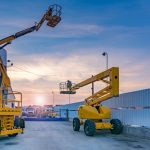Choosing the Right Heavy Equipment: Forklifts vs. Telehandlers
December 25, 2023 10:46 pm Leave your thoughts When it comes to heavy lifting and material handling tasks, having the right equipment is crucial for efficiency and safety. Two commonly used heavy equipment options are forklifts and telehandlers. While these machines may seem similar at first glance, they have distinct differences that make them suitable for different applications. In this blog post, we will explore the main differences between forklifts and telehandlers to help you make an informed decision when choosing the right equipment for your needs.
When it comes to heavy lifting and material handling tasks, having the right equipment is crucial for efficiency and safety. Two commonly used heavy equipment options are forklifts and telehandlers. While these machines may seem similar at first glance, they have distinct differences that make them suitable for different applications. In this blog post, we will explore the main differences between forklifts and telehandlers to help you make an informed decision when choosing the right equipment for your needs.
1. Design and Functionality
One of the primary differences between forklifts and telehandlers lies in their design and functionality. Forklifts are specifically designed for lifting and transporting palletized loads in warehouses or industrial settings. They have a compact design with forks mounted on the front that can be raised and lowered for picking up loads. Forklifts also have a tight turning radius, which makes them highly maneuverable in confined spaces.
In contrast, telehandlers are designed to perform a wider range of tasks beyond lifting and transporting pallets. They feature a telescopic boom that can extend and retract, allowing for higher reach and increased versatility. Telehandlers can not only lift loads vertically like a forklift but also extend the boom forward, enabling them to reach higher and further distances. This makes telehandlers suitable for construction sites, agricultural applications, and other industries that require versatile and long-reaching equipment.
2. Lifting Capacity and Height
Another significant difference between forklifts and telehandlers is their lifting capacity and height capabilities. Forklifts typically have a lower lifting capacity compared to telehandlers. While some heavy-duty forklifts can handle loads up to 50,000 pounds, the average forklift has a lifting capacity ranging from 2,000 to 15,000 pounds.
Telehandlers, on the other hand, have a higher lifting capacity, making them suitable for heavy-duty lifting tasks. They can handle loads ranging from 5,000 to 30,000 pounds or more, depending on the model. Telehandlers also have a greater lifting height capability due to their telescopic boom. They can reach heights of up to 55 feet or more, whereas forklifts generally have a limited lifting height.
3. Versatility and Attachments
When it comes to versatility and attachments, telehandlers have the upper hand. Their telescopic boom allows them to be equipped with various attachments, expanding their range of applications. Some common attachments for telehandlers include buckets, pallet forks, lift hooks, and material grabs. These attachments enable telehandlers to perform tasks such as bucket loading, material handling, and lifting loads in hard-to-reach areas.
While forklifts also have attachment options, they are often limited to fork extensions or specialized attachments for specific functions. Forklift attachments are typically focused on pallet handling, such as clamps for handling drums or rotators for handling crates. Forklifts are less versatile than telehandlers when it comes to adapting to different tasks or working in challenging environments.
4. Terrain and Stability
Forklifts and telehandlers differ in terms of their terrain capabilities and stability. Forklifts are specifically designed for indoor use on smooth surfaces, such as concrete floors. With their smaller size and design, they excel in navigating narrow aisles and tight spaces commonly found in warehouses.
In contrast, telehandlers are built for outdoor use and are capable of handling rough terrain. They have larger wheels and better ground clearance, allowing them to operate on uneven surfaces, gravel, mud, or construction sites. Telehandlers also offer better stability due to their wider wheelbase, making them suitable for lifting and maneuvering loads on challenging terrains.
Summary
When choosing between a forklift and a telehandler, it is essential to consider the specific requirements of your project or application. Forklifts are ideal for indoor material handling and palletized loads, while telehandlers offer greater versatility, higher lifting capacities, and the ability to handle rough terrains. Evaluate your lifting needs, working environment, and available attachments to determine which equipment will best meet your requirements. Consult with a trusted equipment supplier or rental company to ensure you make the right choice for your business or project.
Need Heavy Equipment Experts in Abilene, TX?
At V-Bar Equipment Company, we offer a wide range of skid steer grapples to suit the diverse needs of our clients. From root grapples and rock grapples to brush grapples and industrial grapples, our inventory is stocked with high-quality attachments designed to handle different materials and applications. Visit our inventory page to explore the different types of grapples we offer. Our knowledgeable team is ready to assist you in selecting the perfect grapple attachment for your skid steer loader. Contact us today to learn more about what we can do for you!
Categorised in: Forklift Rental, Forklifts, Heavy Equipment, Telehandler Lifts
This post was written by admin
